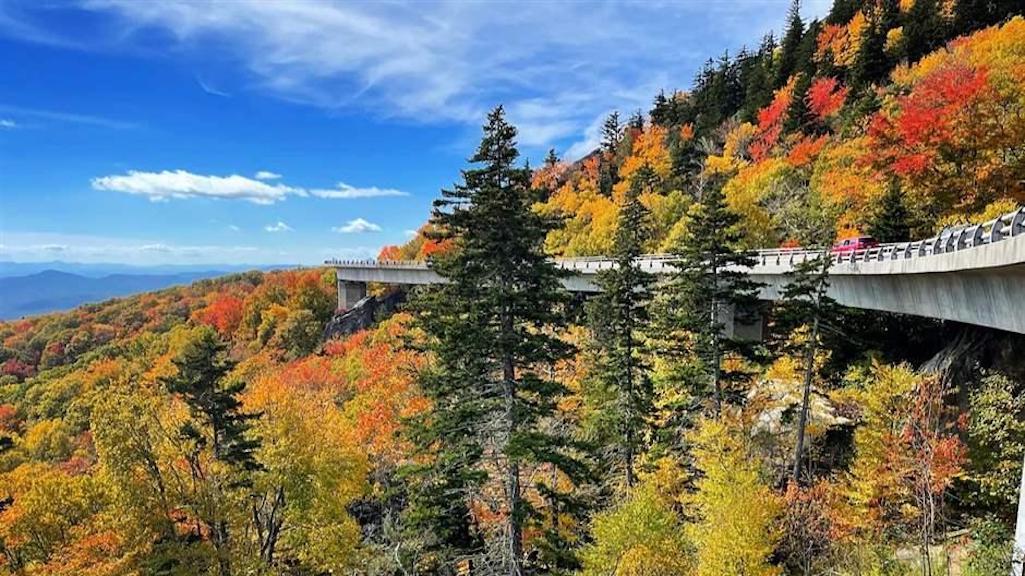
The Blue Ridge Parkway, which runs for 469 miles through the Appalachian Mountains of Virginia, North Carolina, and Tennessee, could benefit from repair funds provided in the Infrastructure Investment and Jobs Act. President Joe Biden signed the bill into law Nov. 15/The Pew Charitable Trusts
Horace M. Albright, who helped found the National Park Service (NPS) and led it from 1929 to 1933, once wrote that “the national parks are more than the storehouses of nature’s rarest treasures. They are the playlands of the people, wonderlands easily accessible to the rich and the humble alike.”
And one reason for that ease of access is the thousands of miles of roads laced through the park system. But the cost of maintaining the roads, bridges, and tunnels exceeds the NPS’ annual transportation budget.
Fortunately, help is on the way: The Infrastructure Investment and Jobs Act, which Congress passed and President Joe Biden signed into law Nov. 15, provides capital over the next five years for the NPS to preserve and upgrade its transportation network, which includes more than 5,500 miles of publicly accessible roads, 1,400 bridges, 60 tunnels, and 6,100 parking areas. The funds will flow through two federal accounts: the Federal Lands Transportation Program (FLTP) and the Nationally Significant Federal Lands and Tribal Projects (NSFLTP) Program.
The FLTP is authorized as part of the Highway Trust Fund and is jointly managed by the NPS and the Federal Highway Administration. The program will provide $1.7 billion over five years to the NPS, starting with $332 million in fiscal year 2022 and ramping up to $360 million in fiscal 2026.
The FLTP is important because parks need well-maintained transportation networks to provide visitors with safe access and quality experiences. Many features and attractions within parks are accessible by motor vehicle, and most visitors stick to these roads and nearby routes during their visits.

In Fiscal Year 2018, Crater Lake National Park in Oregon received an $ 1.84 million grant to rehabilitate historic West Rim Drive, which provides scenic views of the lake and the dormant volcano’s caldera. The Infrastructure Investment and Jobs Act will help fund similar projects/National Park Service

Denali National Park and Preserve in Alaska used FLTP funds to develop a concrete box culvert bridge over Krier’s Creek to eliminate barriers to fish crossing under Denali Park Road/National Park Service
The program originally provided funding only if members of Congress requested it through annual appropriations, but new provisions now provide $55 million in guaranteed annual funds to NSFLTP, or $275 million over the next five years. Congress is authorized to appropriate up to $300 million a year in additional funds, for a potential program total of $1.5 billion over five years.

In 2019, the NPS received $60 million in NSFLTP funds to construct small bridges across a 6.5-mile section of the Tamiami Trail in Everglades National Park, a project that will help mitigate flooding of the road and allow wildlife to cross into the park from nearby marshes/National Park Service
Marcia Argust is director and Tom St. Hilaire a senior officer for The Pew Charitable Trusts’ U.S. public lands and rivers conservation project.

 Support Essential Coverage of Essential Places
Support Essential Coverage of Essential Places




Comments
Great news. Hopefully FLTP funds coupled with Great American Outdoors Act of 2020 will help with vast road network improvements in the NPS system. Plus full funding for LWCF is a win-win.
Tbe NPS doesn't need more money to solve the "deferred maintenance backlog". Remember Fee Demo, then decades of FLREA, then GAO none of them reduced the "backlog". The NPS should remove all authority and responsibilities for construction and repair from the Facilities Division.
"Deferred maintenance backlog " is a term invented by the Maintenance Division nearly thirty years ago to ensure that new funds stayed in their Division. It was pure genius, they have duped many Superintendents and Regional Directors and members of Congress into believing that more money will solve the problem. At the same time they fail to accomplish normal routine maintenance of facilities with the direct intent that the facility degrades so it can be put on the "deferred maintenance " list. A cycle that rewards incompetence.
Professional project management, conducted by those who have no interest or motivation to perpetuate the "deferred maintenance backlog " is what the NPS needs. This could be accomplished by Congress attaching conditions on how the money gets spent.
As a veteran of the NPS's so-called Maintenance Division from the seventies until 2000, I agree with 'retiree's comment. New facilities seemed (and still are) a much higher management priority than maintenance of existing infrastructure. This further increased the backlog by diverting employee time and project funding to development while adding to the future maintenance inventory. I guess nobody ever got promoted to Virgin Islands by just taking proper care of what they already had...